Jack Dempsey
Jack Dempsey was a defensively sound puncher. He stood 6’1 and weighed 190 at his heaviest. Therefore he knew that he would have to get in on the inside against heavyweights who were bigger than him. Dempsey also knew that he would have to use an effective method to close the distance against the faster, more scientific boxers. So Dempsey used the bob and weave technique to a great extent throughout his career.
Dempsey would keep his chin tucked under his shoulder. That way his chin was protected, as any punch aimed at his chin would hit his shoulder, and his head movement would ensure that his chin would not take solid hits. Gene Tunney remarked that in two fights and twenty rounds, he never had a chance to hit Dempsey on the chin in spite of intense preparation because Dempsey protected his chin behind his shield of a shoulder. When he hit Dempsey in the first round of the first fight, it landed on the temple, not the chin as Tunney intended.
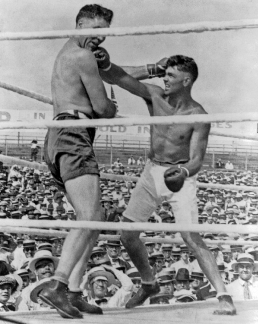
Dempsey would also bob and weave as he punched. This action made him a harder target to hit than if he stopped to punch. His bob and weave was a sophisticated pendulum movement designed to get under and around punches so that he could counter. In his book, he described how he would vary his bob and weave so as to be more unpredictable and counter off of opponent’s misses.
He would also side-step, and step back. His movements in the ring were not an uncontrolled bull rush, but a ballet of pugilistic destruction. When the heavyweight champion Jess Willard jabbed at him in the championship fight of 1919, he side-stepped that shot and hit Willard with a right hand to the body. Dempsey coupled his bob and weave with his footwork to make a great combination of defense. Dempsey fought on his toes to facilitate faster footwork.
Dempsey wrote a book called Championship Boxing, in which he further highlighted defensive techniques. He was scornful of leaning back as a defensive technique, but Jack Johnson and Muhammad Ali used this defensive technique in their repertoire.
Joe Louis
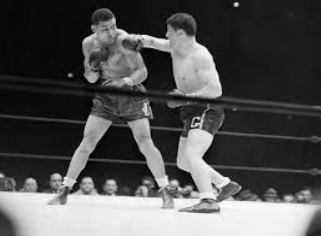
Joe Louis also had good defense. Sportswriters of his time argued over the quality of his defense. Nat Fleischer said that he was outstanding and that his defense was on par with Jack Johnson. Other writers said that his defense was mediocre and that he was hittable against great fighters. The truth probably lies somewhere in between. Joe Louis’s defense evolved based on the fighter that he was facing. But one of the centerpieces of his defense was his stellar jab. He used it to both keep opponents off balance and to intercept attacks. He was taught defense by Jack Blackburn, who was one of the great black fighters of the early 20th century. Blackburn taught Louis how to shoulder block punches, and how to block body punches using different techniques depending on the angles. He also showed Louis how to block jabs, hooks, uppercuts and right hands. Joe Louis, like Jack Dempsey, did not do much leaning back. Blackburn also told Louis not to fight on his toes and move away, but to fight more flat-footed so that he could generate more power.
For the James Braddock title fight, Blackburn also coached Louis on bobbing and weaving to get inside and counter off of a miss. In the Max Schmeling fight, Louis used a combination of head movement and glove blocking to get inside and wreak havoc on Schmeling. In the Jersey Joe Walcott fights, he used slipping and ducking to remain in range while trading shots with Walcott. He also used some of the blocking, particularly the shoulder blocking, that was taught to him by Blackburn.
Muhammad Ali
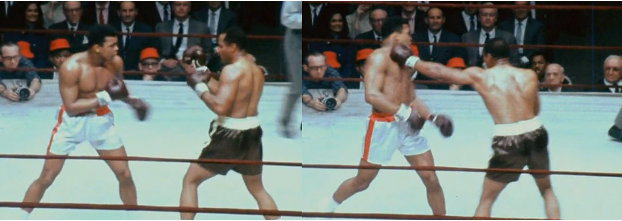
Muhammad Ali had stellar defense at every phase of his career. In the early part of his career, before the exile, he himself said that his defense relied heavily on his legs. Ali would circle away from his opponents and would do so stepping either to the right or to the left. When Ali chose to step straight backward he would simply walk backward, instead of moving the rear foot first and then the front foot. Ali would lean away from punches, and would lean either straight back or off to the side. This would cause his opponents to over-extend their punches and be vulnerable to his counters. To avoid body shots, Ali would use footwork to step around it as he did with Liston. Ali would combine his leaning away with his right hand in a technique he called the anchor punch. This punch knocked down Liston and Folley.
In the second phase of his career, after the exile, Ali relied on blocking and clinching more. Against Joe Frazier the second time, he would hold his right hand to his cheek to intercept Joe Frazier’s hook. Also, Ali would clinch by pulling down on Frazier’s head when Frazier came close so that Frazier could not punch at him. However, Ali never learned to block Norton’s jab because Norton would jab as Ali was jabbing and Ali held his right hand out to the side instead of in the proper parrying position. Against Foreman, Ali would catch the punches of Foreman on his arms and elbows so that Foreman could not get at his body with regularity. Also, Ali leaned away from Foreman’s punches at his head, and used the ropes to facilitate this tactics. Ali would tie up Foreman’s arms, and this weakened Foreman’s power. Ali was a defensive master who was on par with the defensive greats in any division.
George Foreman
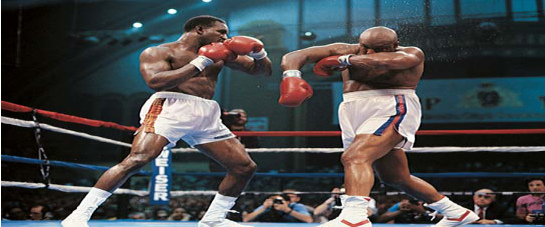
George Foreman was underrated defensively but he was generally sound. In his early career, he would hold his hands out and push his opponent’s shoulders backward. This tactic would take the power out of his opponent’s punches. If Foreman’s opponents tried to punch straight, then the punches would by caught by Foreman’s hands. If his opponents tried to use hooks, then they could be blocked by Foreman’s biceps and shoulders. Foreman would also wrestle with his opponents as they tried to move inside, and they would be a sitting target for his uppercuts.
In Foreman’s comeback, he used the cross-armed guard extensively. This served to protect his relatively stationary head, as Foreman did not use much head movement. Also Foreman did not crouch down when using this guard, but instead stood straight. This guard was a barrier to punches, as the opponent would have to get through his crossed arms to get at Foreman.
Mike Tyson
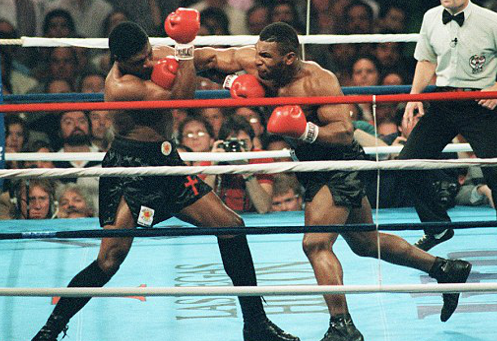
Mike Tyson was stellar defensively, but his defense suffered as he got older. He fought out of the peek a boo stance, with his hands held straight up to ward off blows. Tyson was adept at glove and forearm blocking but preferred to use head and upperbody movement. His upperbody movement was unique, in that he would move from side to side, instead of up and down. This meant that he could also slip uppercuts, which Joe Frazier was vulnerable to in his fight with Foreman. He would also use a shift where he would punch, slip to the other side while shifting his feet, and punch from this new stance. But as Tyson got older and lost desire, the head movement left him and he became more stationary and hittable.